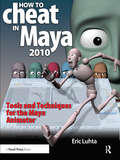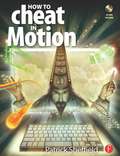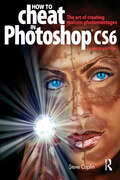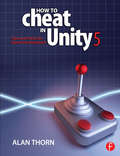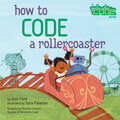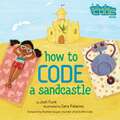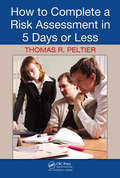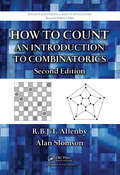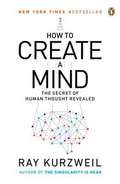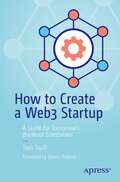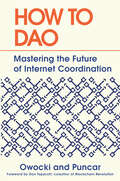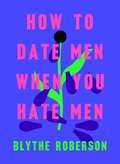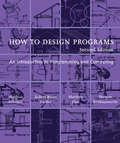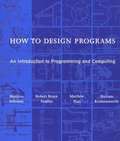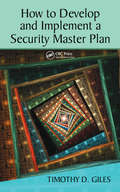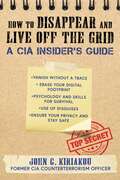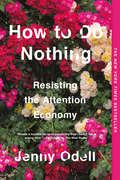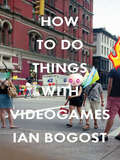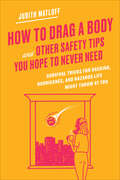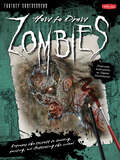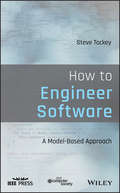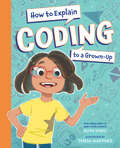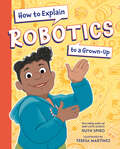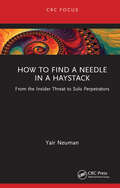- Table View
- List View
How to Cheat in Maya: Tools and Techniques for the Maya Animator (How To Cheat In Ser.)
by Eric LuhtaTake your animations to the next level with this essential guide to Maya 2010. Packed with character animation techniques and the secrets of professional animators, How to Cheat in Maya 2010 provides the tips and tools to help you create high quality animation in the most efficient way possible. This comprehensive guide to animating with Maya contains gold-mine coverage, including animation techniques, using Maya's tools with the 12 animation principles, working with constraints, and even foolproof lighting tricks to show off your work. With this essential handbook, learn which circumstances call for which techniques, and how to get quality results fast. You will not only learn how to be productive in Maya, but also be given access under the hood to the actual scene files of a professional animator. Covering such topics such as pose to pose blocking, layered animation, fixing gimbal lock, facial animation, and much more, How to Cheat in Maya 2010 is an invaluable resource for artists and animators alike.-- See "under the hood" of a professional animator's workflow with beginning and ending scene files for every technique and workflow example in the book. --Complete, step-by-step walkthroughs of essential techniques every animator needs to know such as walk cycles, pose-to-pose blocking, lip syncing to dialogue, and much, much more.-- Proven "How to Cheat" series - Learn to create impressive, appealing animations using the fastest techniques possible, containing everything you need to know about Maya as a character animator.--Includes rarely discussed topics, such as reading spline curves, avoiding gimbal lock, animation layers, creating appealing lighting for demo reels, and features interviews with some of the most experienced animation leads and TDs working in the industry -- Learn to apply these professional techniques to your own animations with the accompanying downloadable resources which include all scene files to follow along with, as well as final versions to study in the Graph Editor
How to Cheat in Motion
by Patrick SheffieldThe text provides a "cookbook" style of learning computer animation, presenting the user with specific recipes to achieve desirable outcomes. This practical guide helps readers to enhance titles, motion graphics and visual effects with Motion. Step-by-step instruction is concisely described and lavishly illustrated.
How to Cheat in Photoshop CS6: The art of creating realistic photomontages
by Steve CaplinWith enough charm and wit to make learning Photoshop anything but taxing, Steve Caplin delivers the next instalment of the How to Cheat series, containing all the techniques you need to create and master the art of photomontage. Delivered in easy to follow step-by-step tutorials How to Cheat in Photoshop covers all the basics of selections and layers before moving onto top tricks and techniques for creating realistic works of art for business, pleasure, or something in between. An accompanying DVD is packed full of practice images and tutorial movies for you to working along with, plus bonus chapters to push your skills even further. Using a tweaked design that is clearer and fresher than previous editions this is the funnest way to master Photomontage.
How to Cheat in Unity 5: Tips and Tricks for Game Development
by Alan ThornLooking to become more efficient using Unity? <P><P>How to Cheat in Unity 5 takes a no-nonsense approach to help you achieve fast and effective results with Unity 5. Geared towards the intermediate user, HTC in Unity 5 provides content beyond what an introductory book offers, and allows you to work more quickly and powerfully in Unity. Packed full with easy-to-follow methods to get the most from Unity, this book explores time-saving features for interface customization and scene management, along with productivity-enhancing ways to work with rendering and optimization. In addition, this book features a companion website at www.alanthorn.net, where you can download the book’s companion files and also watch bonus tutorial video content. <P><P>Learn bite-sized tips and tricks for effective Unity workflows <P><P>Become a more powerful Unity user through interface customization <P><P>Enhance your productivity with rendering tricks, better scene organization and more <P><P>Better understand Unity asset and import workflows <P><P>Learn techniques to save you time and money during development
How to Code a Rollercoaster
by Josh FunkPearl and Pascal take their coding adventures to the amusement park in this follow-up picture book from our Girls Who Code program!Pearl and her trusty rust-proof robot, Pascal, are enjoying a day out at the amusement park. Spinning teacups, ice cream, and of course: rollercoasters! Through the use of code, Pearl and Pascal can keep track of their ride tokens and calculate when the line is short enough to get a spot on the biggest ride of them all--the Python Coaster. Variables, if-then-else sequences, and a hunt for a secret hidden code make this a humorous, code-tastic day at the amusement park!
How to Code a Sandcastle
by Josh FunkFrom the computer science nonprofit Girls Who Code comes this lively and funny story introducing kids to computer coding concepts.All summer, Pearl has been trying to build the perfect sandcastle, but out-of-control Frisbees and mischievous puppies keep getting in the way! Pearl and her robot friend Pascal have one last chance, and this time, they&’re going to use code to get the job done. Using fundamental computer coding concepts like sequences and loops, Pearl and Pascal are able to break down their sandcastle problem into small, manageable steps. If they can create working code, this could turn out to be the best beach day ever! With renowned computer science nonprofit Girls Who Code, Josh Funk and Sara Palacios use humor, relatable situations, and bright artwork to introduce kids to the fun of coding.
How to Complete a Risk Assessment in 5 Days or Less
by Thomas R. PeltierSuccessful security professionals have had to modify the process of responding to new threats in the high-profile, ultra-connected business environment. But just because a threat exists does not mean that your organization is at risk. This is what risk assessment is all about. How to Complete a Risk Assessment in 5 Days or Less demonstrates how to identify threats your company faces and then determine if those threats pose a real risk to the organization. To help you determine the best way to mitigate risk levels in any given situation, How to Complete a Risk Assessment in 5 Days or Less includes more than 350 pages of user-friendly checklists, forms, questionnaires, and sample assessments. Presents Case Studies and Examples of all Risk Management Components based on the seminars of information security expert Tom Peltier, this volume provides the processes that you can easily employ in your organization to assess risk. Answers such FAQs as: Why should a risk analysis be conducted Who should review the results? How is the success measured? Always conscious of the bottom line, Peltier discusses the cost-benefit of risk mitigation and looks at specific ways to manage costs. He supports his conclusions with numerous case studies and diagrams that show you how to apply risk management skills in your organization-and it's not limited to information security risk assessment. You can apply these techniques to any area of your business. This step-by-step guide to conducting risk assessments gives you the knowledgebase and the skill set you need to achieve a speedy and highly-effective risk analysis assessment in a matter of days.
How to Count: An Introduction to Combinatorics, Second Edition
by R.B.J.T. Allenby Alan SlomsonEmphasizes a Problem Solving ApproachA first course in combinatoricsCompletely revised, How to Count: An Introduction to Combinatorics, Second Edition shows how to solve numerous classic and other interesting combinatorial problems. The authors take an easily accessible approach that introduces problems before leading into the theory involved. Although the authors present most of the topics through concrete problems, they also emphasize the importance of proofs in mathematics.New to the Second EditionThis second edition incorporates 50 percent more material. It includes seven new chapters that cover occupancy problems, Stirling and Catalan numbers, graph theory, trees, Dirichlet's pigeonhole principle, Ramsey theory, and rook polynomials. This edition also contains more than 450 exercises. Ideal for both classroom teaching and self-study, this text requires only a modest amount of mathematical background. In an engaging way, it covers many combinatorial tools, such as the inclusion-exclusion principle, generating functions, recurrence relations, and Polya's counting theorem.
How to Create a Mind: The Secret of Human Thought Revealed
by Ray KurzweilThe bestselling author of The Singularity Is Near explores the limitless potential of reverse-engineering the human brain Ray Kurzweil is arguably today's most influential futurist. In How to Create a Mind, he presents a provocative exploration of the most important project in the human-machine civilization: reverse-engineering the brain to understand precisely how it functions and using that knowledge to create even more intelligent machines. Kurzweil discusses how the brain works, how the mind emerges, brain-computer interfaces, and the implications of vastly increasing the powers of our intelligence to address the world's problems. Certain to be one of the most widely discussed and debated science books of the year, How to Create a Mind is sure to take its place alongside Kurzweil's previous classics.
How to Create a Mind: The Secret of Human Thought Revealed
by Ray KurzweilThe bold futurist and bestselling author explores the limitless potential of reverse-engineering the human brainRay Kurzweil is arguably today’s most influential—and often controversial—futurist. In How to Create a Mind, Kurzweil presents a provocative exploration of the most important project in human-machine civilization—reverse engineering the brain to understand precisely how it works and using that knowledge to create even more intelligent machines.Kurzweil discusses how the brain functions, how the mind emerges from the brain, and the implications of vastly increasing the powers of our intelligence in addressing the world’s problems. He thoughtfully examines emotional and moral intelligence and the origins of consciousness and envisions the radical possibilities of our merging with the intelligent technology we are creating.Certain to be one of the most widely discussed and debated science books of the year, How to Create a Mind is sure to take its place alongside Kurzweil’s previous classics which include Fantastic Voyage: Live Long Enough to Live Forever and The Age of Spiritual Machines.From the Hardcover edition.
How to Create a Web3 Startup: A Guide for Tomorrow’s Breakout Companies
by Tom TaulliWeb3 is the next evolution for the World Wide Web based on Blockchain technology. This book will equip entrepreneurs with the best preparation for the megatrend of Web3 by reviewing its core concepts such as DAOs, tokens, dApps, and Ethereum.With Web2, much of the valuable data and wealth has been concentrated with a handful of mega tech operators like Apple, Facebook, Google and Amazon. This has made it difficult for startups to get an edge. It has also meant that users have had little choice but to give up their value data for free. Web3 aims to upend this model using a decentralized approach that is on the blockchain and crypto. This allows for users to become stakeholders in the ecosystem. Along with exploring core concepts of Web3 like DAOs, tokens, dApps, and Ethereum, this book will also examine the main categories that are poised for enormous opportunities. They include infrastructure, consumer apps, enterprise apps, and the metaverse. For each of these, I will have use cases of successful companies. How To Create a Web3 Startup covers the unique funding strategies, the toolsets needed, the talent required, the go-to-market approaches, and challenges faced. What You'll LearnWork with the dev stack componentsExamine the success factors for infrastructure, consumer, enterprise, verticals, and the MetaverseUnderstand the risks of Web3, like the regulatory structure and security breachesWho This Book Is ForStartup entrepreneurs and those looking to work in the Web3 industry.
How to DAO: Mastering the Future of Internet Coordination
by Kevin Owocki PuncarWelcome to the future of internet coordination.By now you&’ve heard the buzz about Decentralized Autonomous Organizations (DAOs), and how they are going to redefine how we work and earn.But when you peel away the hype and tech jargon, what are they really? How do they operate, why do they matter, and how can we all thrive in this brave new world of work?In How to DAO, industry veterans Kevin Owocki and Puncar take you on an illuminating journey into the world of groundbreaking change, exploring the principles of decentralized finance, and teaching the brass tacks of setting up and managing your own DAO, from smart contracts to governance and innovation.With How to DAO, discover what DAOs are really about, and learn the tips and tricks you need to harness the limitless potential of this transformative new technology.
How to Date Men When You Hate Men
by Blythe RobersonFrom New Yorker and Onion writer and comedian Blythe Roberson, How to Date Men When You Hate Men is a comedy philosophy book aimed at interrogating what it means to date men within the trappings of modern society. Blythe Roberson’s sharp observational humor is met by her open-hearted willingness to revel in the ugliest warts and shimmering highs of choosing to live our lives amongst other humans. She collects her crushes like ill cared-for pets, skewers her own suspect decisions, and assures readers that any date you can mess up, she can top tenfold. And really, was that date even a date in the first place?With sections like Real Interviews With Men About Whether Or Not It Was A Date; Good Flirts That Work; Bad Flirts That Do Not Work; and Definitive Proof That Tom Hanks Is The Villain Of You’ve Got Mail, How to Date Men When You Hate Men is a one stop shop for dating advice when you love men but don't like them."With biting wit, Roberson explores the dynamics of heterosexual dating in the age of #MeToo"— The New York Times
How to Design Programs, second edition: An Introduction to Programming and Computing (The\mit Press Ser.)
by Matthias Felleisen Robert Bruce Findler Shriram Krishnamurthi Matthew FlattA completely revised edition, offering new design recipes for interactive programs and support for images as plain values, testing, event-driven programming, and even distributed programming.This introduction to programming places computer science at the core of a liberal arts education. Unlike other introductory books, it focuses on the program design process, presenting program design guidelines that show the reader how to analyze a problem statement, how to formulate concise goals, how to make up examples, how to develop an outline of the solution, how to finish the program, and how to test it. Because learning to design programs is about the study of principles and the acquisition of transferable skills, the text does not use an off-the-shelf industrial language but presents a tailor-made teaching language. For the same reason, it offers DrRacket, a programming environment for novices that supports playful, feedback-oriented learning. The environment grows with readers as they master the material in the book until it supports a full-fledged language for the whole spectrum of programming tasks.This second edition has been completely revised. While the book continues to teach a systematic approach to program design, the second edition introduces different design recipes for interactive programs with graphical interfaces and batch programs. It also enriches its design recipes for functions with numerous new hints. Finally, the teaching languages and their IDE now come with support for images as plain values, testing, event-driven programming, and even distributed programming.
How to Design Programs: An Introduction to Programming and Computing
by Matthias Felleisen Robert Bruce Findler Shriram Krishnamurthi Matthew FlattThis introduction to programming places computer science in the core of a liberal arts education. Unlike other introductory books, it focuses on the program design process. This approach fosters a variety of skills--critical reading, analytical thinking, creative synthesis, and attention to detail--that are important for everyone, not just future computer programmers. The book exposes readers to two fundamentally new ideas. First, it presents program design guidelines that show the reader how to analyze a problem statement; how to formulate concise goals; how to make up examples; how to develop an outline of the solution, based on the analysis; how to finish the program; and how to test. Each step produces a well-defined intermediate product. Second, the book comes with a novel programming environment, the first one explicitly designed for beginners. The environment grows with the readers as they master the material in the book until it supports a full-fledged language for the whole spectrum of programming tasks. All the book's support materials are available for free on the Web. The Web site includes the environment, teacher guides, exercises for all levels, solutions, and additional projects.
How to Develop and Implement a Security Master Plan
by Timothy GilesWritten for corporation security officers, this work is designed to help them garner executive support and increased funding for their security programs. It provides a thorough examination of the Security Master Planning process, explaining how to develop appropriate risk mitigation strategies and how to focus on both effectiveness and efficiency while conducting a site security assessment. The author constructs a comprehensive five-year plan that is synchronized with the strategies of a business or institution. This is a valuable reference tool for security professionals of small and large corporations, as well as for consultants in the field.
How to Disappear and Live Off the Grid: A CIA Insider's Guide
by John KiriakouWith an experienced CIA officer as your teacher, you&’ll gain the knowledge and necessary tools to protect yourself and the ones you love.No matter where we go, we leave tracks and clues of our existence without even knowing. Our electronic footprint becomes our invisible trail. In this day in age where the world seems to be at our fingertips and social media plays a huge role in our daily lives, it&’s hard not to leave part of our digital selves for others to find.Whether you&’re fascinated by the idea of disappearing, want to erase your digital footprint, or simply concerned about your safety and privacy, knowing how to become invisible is a survival skill that will come in handy.Through the easy-to-follow instructions, tips, tricks, and professional anecdotes in How to Disappear and Live off the Grid: A CIA Insider's Guide, you&’ll learn to vanish without a trace from John Kiriakou, a former CIA counterterrorism officer and senior investigator for the Senate Foreign Relations Committee responsible for the capture of Abu Zubaydah.
How to Do Nothing: Resisting the Attention Economy
by Jenny OdellA galvanizing critique of the forces vying for our attention—and our personal information—that redefines what we think of as productivity, reconnects us with the environment, and reveals all that we’ve been too distracted to see about ourselves and our world <P><P>Nothing is harder to do these days than nothing. But in a world where our value is determined by our 24/7 data productivity . . . doing nothing may be our most important form of resistance. So argues artist and critic Jenny Odell in this field guide to doing nothing (at least as capitalism defines it). <P><P>Odell sees our attention as the most precious—and overdrawn—resource we have. Once we can start paying a new kind of attention, she writes, we can undertake bolder forms of political action, reimagine humankind’s role in the environment, and arrive at more meaningful understandings of happiness and progress. <P><P>Far from the simple anti-technology screed, or the back-to-nature meditation we read so often, How to do Nothing is an action plan for thinking outside of capitalist narratives of efficiency and techno-determinism. Provocative, timely, and utterly persuasive, this book is a four-course meal in the age of Soylent. <P><P><b>A New York Times Bestseller</b>
How to Do Things with Videogames (Electronic Mediations)
by Ian BogostIn recent years, computer games have moved from the margins of popular culture to its center. Reviews of new games and profiles of game designers now regularly appear in the New York Times and the New Yorker, and sales figures for games are reported alongside those of books, music, and movies. They are increasingly used for purposes other than entertainment, yet debates about videogames still fork along one of two paths: accusations of debasement through violence and isolation or defensive paeans to their potential as serious cultural works. In How to Do Things with Videogames, Ian Bogost contends that such generalizations obscure the limitless possibilities offered by the medium&’s ability to create complex simulated realities. Bogost, a leading scholar of videogames and an award-winning game designer, explores the many ways computer games are used today: documenting important historical and cultural events; educating both children and adults; promoting commercial products; and serving as platforms for art, pornography, exercise, relaxation, pranks, and politics. Examining these applications in a series of short, inviting, and provocative essays, he argues that together they make the medium broader, richer, and more relevant to a wider audience.Bogost concludes that as videogames become ever more enmeshed with contemporary life, the idea of gamers as social identities will become obsolete, giving rise to gaming by the masses. But until games are understood to have valid applications across the cultural spectrum, their true potential will remain unrealized. How to Do Things with Videogames offers a fresh starting point to more fully consider games&’ progress today and promise for the future.
How to Drag a Body and Other Safety Tips You Hope to Never Need: Survival Tricks for Hacking, Hurricanes, and Hazards Life Might Throw at You
by Judith Matloff“Matloff assesses major threats with careful authority and good humor, then gives us the logistical and emotional tools necessary to cope with them.” —Ada Calhoun, New York Times–bestselling author of Why We Can’t SleepIn an age of anxiety, we yearn for some control. We want to make sensible decisions to keep us on track when everything seems to be going off the rails. As a seasoned war correspondent with over thirty years of experience in crisis zones and a pioneering safety consultant, Judith Matloff knows about personal security and risk management. In How to Drag a Body and Other Safety Tips You Hope to Never Need, she shares her tried-and-true methods to help you confidently handle whatever challenges comes your way. Learn how to:Perform emergency first aidCreate a bunkerKeep yourself safe when travelingKeep yourself safe onlineKeep yourself safe in any circumstance with invaluable tips on dozens of other situationsBlending humorous anecdotes with serious advice, Matloff explains how to remain upright in stampedes, avoid bank fraud, prevent sexual assault, stay clean in a shelter, and even be emotionally prepared for loss. From cybersecurity and active shooter situations to natural disasters and emotional resilience, her tips will give even the most anxious person a sense of control over life’s unpredictable perils. Unfortunately, we can’t anticipate all the crises of our lives. But with this book, you’ll find the skills and confidence you need to weather an emergency.Includes illustrations“This wise and witty book will tell you everything you need to know in order to face catastrophes great and small.” —Susan Cain, New York Times–bestselling author of Quiet
How to Draw Zombies
by Walter Foster Creative TeamLearn how to add your own thumbprint to the ever-changing zombie legend with the secrets to drawing, painting, and illustrating the undead.From the pages of great literature to Hollywood movies, zombies are appearing everywhere. Now aspiring artists can bring them to life, so to speak, by learning to render them with pencil, paint, and digital image-editing software. How to Draw Zombies gets into all the gory details, such as creating bloodshot eyes, forming robust brows, and imitating the look of pale, dead flesh. The book also features 15 step-by-step projects that guide artists from initial sketches to finished works of art, including a Voodoo Queen, a zombie climbing out of a grave, a zombie out for a midnight snack, a gothic zombie, and even a zombie romance.
How to Engineer Software: A Model-Based Approach
by Steve TockeyA guide to the application of the theory and practice of computing to develop and maintain software that economically solves real-world problem How to Engineer Software is a practical, how-to guide that explores the concepts and techniques of model-based software engineering using the Unified Modeling Language. The author—a noted expert on the topic—demonstrates how software can be developed and maintained under a true engineering discipline. He describes the relevant software engineering practices that are grounded in Computer Science and Discrete Mathematics. Model-based software engineering uses semantic modeling to reveal as many precise requirements as possible. This approach separates business complexities from technology complexities, and gives developers the most freedom in finding optimal designs and code. The book promotes development scalability through domain partitioning and subdomain partitioning. It also explores software documentation that specifically and intentionally adds value for development and maintenance. This important book: Contains many illustrative examples of model-based software engineering, from semantic model all the way to executable code Explains how to derive verification (acceptance) test cases from a semantic model Describes project estimation, along with alternative software development and maintenance processes Shows how to develop and maintain cost-effective software that solves real-world problems Written for graduate and undergraduate students in software engineering and professionals in the field, How to Engineer Software offers an introduction to applying the theory of computing with practice and judgment in order to economically develop and maintain software.
How to Explain Coding to a Grown-Up (How to Explain Science)
by Ruth SpiroThe best-selling author of the Baby Loves Science series levels up with this playful STEM picture book introducing kids–and grown-ups–to the coding world.Grown-ups do NOT have all the answers! In this tongue-in-cheek guide, an in-the-know narrator instructs perceptive kid readers in the fine art of explaining coding to a grown-up. Both children and their adults learn the basics of coding, including hardware, software, algorithms, and debugging. Cleverly disguised &“pro tips&” suggest best practices for teaching any topic.Fun and fact-filled, the How to Explain Science series will empower kid experts to explore complex scientific concepts with any grown-up who will listen.
How to Explain Robotics to a Grown-Up
by Ruth SpiroThe best-selling author of the Baby Loves Science series levels up with this playful STEM picture book introducing kids–and grown-ups–to the robotics world.Do you want to know a secret? Sometimes grown-ups need YOU to explain things to THEM. Like robotics!In this tongue-in-cheek guide, an in-the-know narrator instructs kid readers in the fine art of explaining robotics to a grown-up. Both children and their adults learn:what makes a robot a robot, who designs and builds robots, and how robots work on their own to get a job done. Fun and fact-filled, the How to Explain Science series will empower kid experts to explore complex scientific concepts with any grown-up who will listen.
How to Find a Needle in a Haystack: From the Insider Threat to Solo Perpetrators
by Yair NeumanSearching for a needle in a haystack is an important task in several contexts of data analysis and decision-making. Examples include identifying the insider threat within an organization, the prediction of failure in industrial production, or pinpointing the unique signature of a solo perpetrator, such as a school shooter or a lone wolf terrorist. It is a challenge different from that of identifying a rare event (e.g., a tsunami) or detecting anomalies because the "needle" is not easily distinguished from the haystack. This challenging context is imbued with particular difficulties, from the lack of sufficient data to train a machine learning model through the identification of the relevant features and up to the painful price of false alarms, which might cause us to question the relevance of machine learning solutions even if they perform well according to common performance criteria. In this book, Prof. Neuman approaches the problem of finding the needle by specifically focusing on the human factor, from solo perpetrators to insider threats. Providing for the first time a deep, critical, multidimensional, and methodological analysis of the challenge, the book offers data scientists and decision makers a deep scientific foundational approach combined with a pragmatic practical approach that may guide them in searching for a needle in a haystack.
